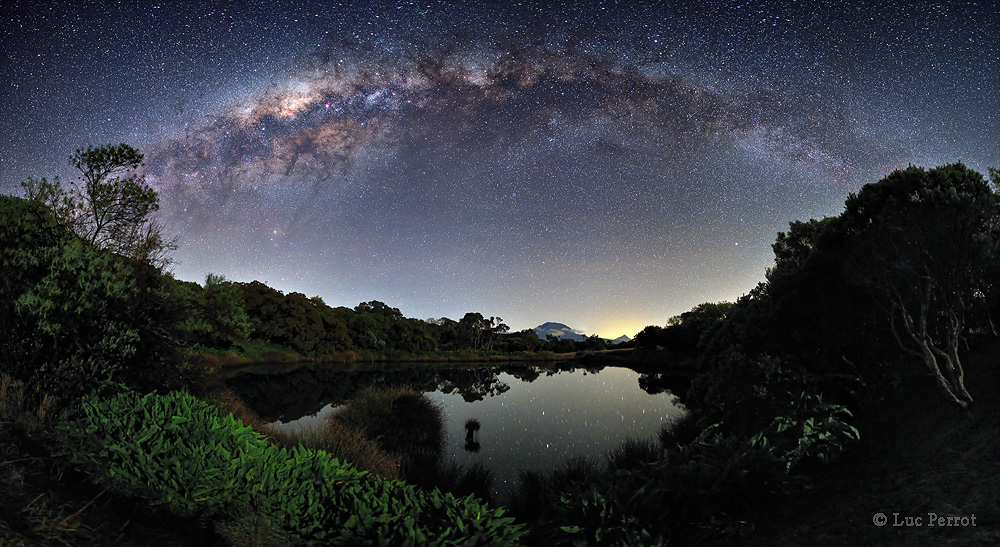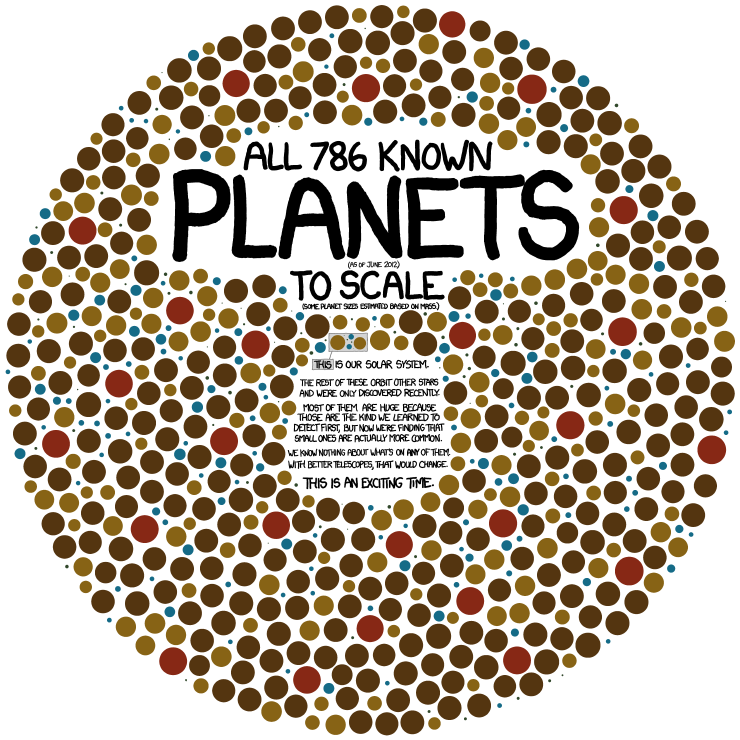Josh Worth’s graphic recreation of the solar system, to scale, with one pixel representing 3474.8 km (that’s 2159.14 mi). If you have the patience to scroll all the way to the gas giants, he has some interesting commentary about the inconceivability of enormous numbers and of the emptiness of space.
by Luc Perrot
Sometimes, if you wait long enough for a clear and moonless night, the stars will come out with a vengeance. One such occasion occurred earlier this month at the Piton de l’Eau on Reunion Island. In the foreground, surrounded by bushes and trees, lies a water filled volcanic crater serenely reflecting starlight. A careful inspection near the image center will locate Piton des Neiges, the highest peak on the island, situated several kilometers away. In the background, high above the lake, shines the light of hundreds of stars, most of which are within 100 light years, right in our stellar neighborhood. Far is the distance, arching majestically overhead, is the central band of our home Milky Way Galaxy, shining by the light of millions of stars each located typically thousands of light years away. The astrophotographer reports waiting for nearly two years for the sky and clouds to be just right to get the above shot.
Says xkcd‘s Randall Munroe:
Planets are turning out to be so common that to show all the planets in our galaxy, this chart would have to be nested in itself–with each planet replaced by a copy of the chart–at least three levels deep.
click to embiggen
Replay it, because after you know where the ejection occurs, you can see the filament breaking away from the surface in the superimposed EUV!
via NASA Goddard on Flickr
The spiral Antennae galaxies are one of the nearest and youngest examples of a pair of colliding galaxies.
NASA, ESA, and the Hubble Heritage Team, STScI/AURA-ESA/Hubble Collaboration – click to embiggen
During the course of the collision, billions of stars will be formed. […] Nearly half of the faint objects in the Antennae image are young clusters containing tens of thousands of stars. The orange blobs to the left and right of image center are the two cores of the original galaxies and consist mainly of old stars criss-crossed by filaments of dust, which appears brown in the image. The two galaxies are dotted with brilliant blue star-forming regions surrounded by glowing hydrogen gas, appearing in the image in pink. The Antennae galaxies take their name from the long antenna-like “arms” extending far out from the nuclei of the two galaxies, best seen by ground-based telescopes.
via the Atlantic’s Hubble Telescope Advent Calendar. More info about the Antennae Galaxies
Today’s image from the Hubble Space Telescope Advent Calendar:
click to embiggen, click again to super-embiggen
The Butterfly Nebula, NGC 6302, is one of the brightest and most extreme planetary nebulae known. What resemble dainty wings are actually roiling cauldrons of gas heated to more than 36,000 degrees Fahrenheit. The gas is tearing across space at more than 600,000 miles an hour. A dying star that was once about five times the mass of the Sun is at the center of this fury. It has ejected its envelope of gases and is now unleashing a stream of ultraviolet radiation that is making the cast-off material glow. […] The glowing gas is the star’s outer layers, expelled over about 2,200 years. The “butterfly” stretches for more than two light-years, which is about half the distance from the Sun to the nearest star, Alpha Centauri.
More info about the nebula at HubbleSite
My friend Lacey pointed me toward the Atlantic’s Hubble Space Telescope Advent Calendar, which I’m loving. Every day, Alan Taylor posts a beautiful photo taken by the Hubble space telescope. Yesterday’s image is of the Retina Nebula, a dying star.
click to embiggen, click again to super-embiggen
A dying star, IC 4406, dubbed the “Retina Nebula” exhibits a high degree of symmetry; the left and right halves of the Hubble image are nearly mirror images of the other. If we could fly around IC 4406 in a starship, we would see that the gas and dust form a vast donut of material streaming outward from the dying star. From Earth, we are viewing the donut from the side. This side view allows us to see the intricate tendrils of dust that have been compared to the eye’s retina. In other planetary nebulae, like the Ring Nebula (NGC 6720), we view the donut from the top. The donut of material confines the intense radiation coming from the remnant of the dying star. Gas on the inside of the donut is ionized by light from the central star and glows. Light from oxygen atoms is rendered blue in this image; hydrogen is shown as green, and nitrogen as red. The range of color in the final image shows the differences in concentration of these three gases in the nebula. Unseen in the Hubble image is a larger zone of neutral gas that is not emitting visible light, but which can be seen by radio telescopes. One of the most interesting features of IC 4406 is the irregular lattice of dark lanes that criss-cross the center of the nebula. These lanes are about 160 astronomical units wide (1 astronomical unit is the distance between the Earth and Sun). They are located right at the boundary between the hot glowing gas that produces the visual light imaged here and the neutral gas seen with radio telescopes. We see the lanes in silhouette because they have a density of dust and gas that is a thousand times higher than the rest of the nebula. The dust lanes are like a rather open mesh veil that has been wrapped around the bright donut. The fate of these dense knots of material is unknown. Will they survive the nebula’s expansion and become dark denizens of the space between the stars or simply dissipate?
More info about the nebula at HubbleSite
Studying hard for my astronomy midterm, and finally got to watch the Astronomy Picture of the Day video for September 20 – Kepler 16b: A Planet with Two Suns.
This artist’s movie illustrates Kepler-16b, the first directly detected circumbinary planet, which is a planet that orbits two stars. The movie begins by showing the gaseous surface of the rotating planet then pans out to show the stars it orbits.
The two orbiting stars regularly eclipse each other, as seen from our point of view on Earth. The planet also eclipses, or transits, each star, and Kepler data from these planetary transits allowed the size, density and mass of the planet to be extremely well determined. The fact that the orbits of the stars and the planet align within a degree of each other indicate that the planet formed within the same circumbinary disk that the stars formed within, rather than being captured later by the two stars.
NASA’s Kepler telescope discovered the planet by observing it cross in front of, or transit, the pair of stars from our point of view on Earth. The stars can also be detected eclipsing each other. Stellar eclipses are shown here, as well as the transits of the planet across both stars.
Such events allow astronomers to measure the sizes of the stars and the planet with extreme accuracy. Kepler-16b is one of the most accurately measured planets outside our solar system, with a size (radius) of 0.7538 that of Jupiter; a mass of 0.333 that of Jupiter (about the mass of Saturn), and a density of 0.964 grams per cubic centimeter. The planet is cold, lying just beyond the “habitable zone” of its star, and is made up of about half gaseous material with a rocky core.
The largest star in the Kepler-16b system is a bit smaller than our sun (about 69 percent of its mass), and the smaller star, called a red dwarf, is even lower in mass (about 20 percent of the sun’s mass).
NASA/JPL-Caltech/T. Pyle
She calls the path of a planet when it’s in retrograde a “whoop-dee-do”. *Love*





